Dear reader: This article contains links to products and services that I may be compensated for, at no extra cost to you.
Taiwan is a country that never stops eating, and a big part of this eating takes place on the streets.
With its legendary night markets and festivals, round-the-clock breakfast shops, recipes honed for generations, and celebrity-status food vendors, there’s always something steaming, sizzling, or stewing on Taiwan’s streets to tempt passersby.
As a nod to Taipei 101, Taiwan’s most iconic landmark, I’ve compiled this bucket list of 101 Taiwanese street foods, spanning all corners of the country, from Taipei to the offshore islands.
The diversity of Taiwanese cuisine is a testimony to the country’s rich cultural history. Aboriginals, Chinese, Hakka, Europeans, Japanese, and Southeast Asians have all left their mark, and each of these influences will be represented in the Taiwanese foods below. (Learn more about Taiwan’s history and culture with my list of interesting Taiwan facts!)
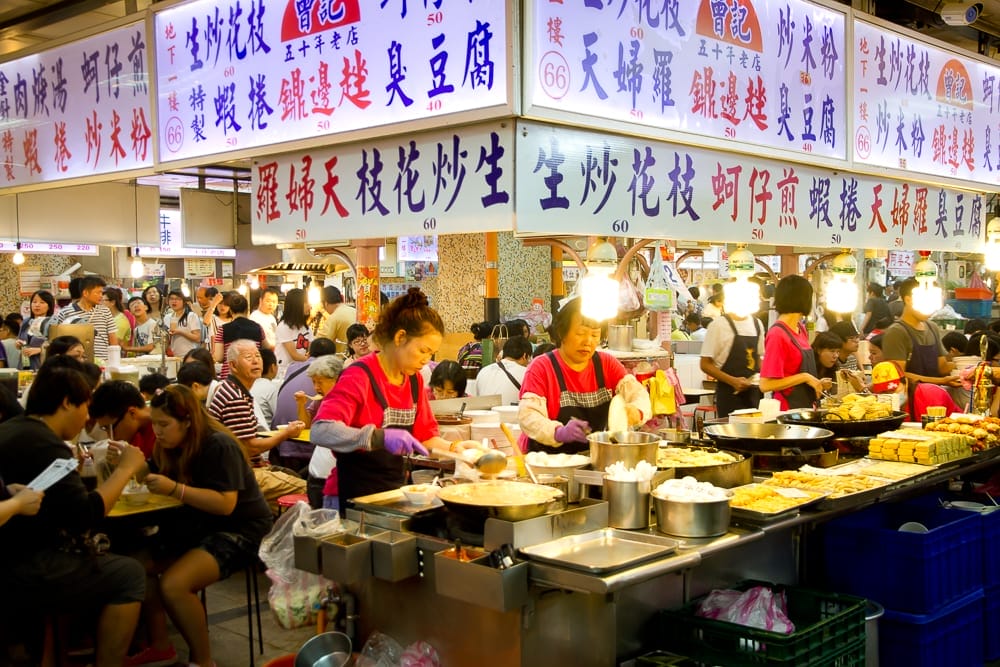
But Taiwanese food is more than just the sum of its influences. Recent decades have seen a growing recognition around the world and by Taiwanese themselves of a national cuisine that is distinctly Taiwanese and is as innovative as it is true to its complex past. Much of this innovation has taken place on the streets, thus it on the streets that you’ll find the true taste of Taiwan.
For restaurant foods, that’s a whole other world. If you’re interested to take a peek into it, check out my guide to the top restaurants in Taipei, organized by style of food. Many years of eating have gone into it!
For vegetarians and vegans, you might want to head to this article introducing more than 90 vegetarian streets food stalls in night markets across Taiwan!
*Note about language: I’ve written food names in English, Mandarin, pinyin, or the Taiwanese language first, depending on what is most commonly used by English speakers in Taiwan, or in some cases, my personal preference.
I highly recommend this book about the history of Taiwanese cuisine and this Taiwanese recipe book!
Table of Contents
Top 10 Taiwanese Foods
Introducing the ultimate, you-haven’t-been-to-Taiwan-if-you-haven’t-tried-these Taiwanese street foods! If you’re taking a trip to Taiwan or planning on moving to Taiwan, consider these your entry level foods guaranteed to lead to an addiction.
1. Oyster Omelet (O-A-Chian/蚵仔煎)
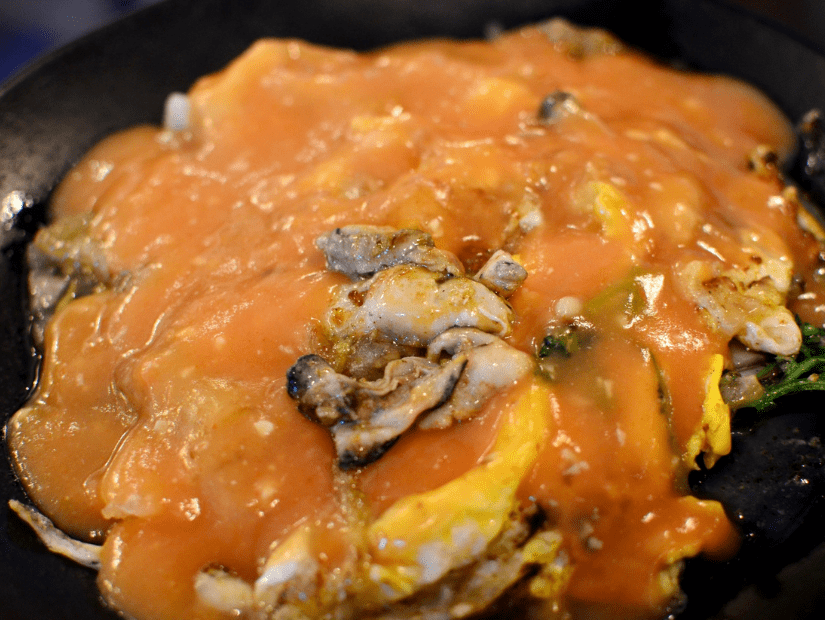
What is it? Eggs, greens, and oysters fried in batter and topped with a sweet & sour sauce. Options may include shrimp and spicy sauce.
Where to find it: Night markets in Taipei, night markets in Taichung and across Taiwan. Ningxia Night Market in Taipei and the underground section of Shilin Night Market are especially known for them.
2. Stinky Tofu (Chou Doufu/臭豆腐)

What is it? A super stinky but surprisingly delicious dish consisting of deep fried tofu cubes served with pickled cabbage or hunks of firm tofu stewed in a spicy broth.
Where to find it: Night markets across Taiwan. Shenkeng Old Street in New Taipei City is a whole street dedicated to stinky tofu, while Nanjichang, Tonghua, and Raohe Night Market have Michelin-rated stinky tofu stalls.
3. Beef Noodles (Niurou Mian/牛肉麵)

What is it? A Taiwanese adaptation of noodles in a beef-based broth brought over by KMT solders from China. Also called red braised beef noodles or beef noodle soup.
Where to find it: Dedicated hole-in-the-wall shops, here in Ximending, Taipei Main Station area, and Yongkang Street in Taipei have some of the most famous ones.
4. Gua Bao (Taiwanese Hamburger/割包)

What is it? A slice of pork belly stuffed into a steamed bun and served with cilantro, pickled mustard greens, and ground peanut. Also called pork belly buns.
Where to find it: Night markets across Taiwan. Try Tonghua Night Market or Feng Chia Night Market in Taichung, or
5. Lu Rou Fan (Braised Pork Rice/滷肉飯)
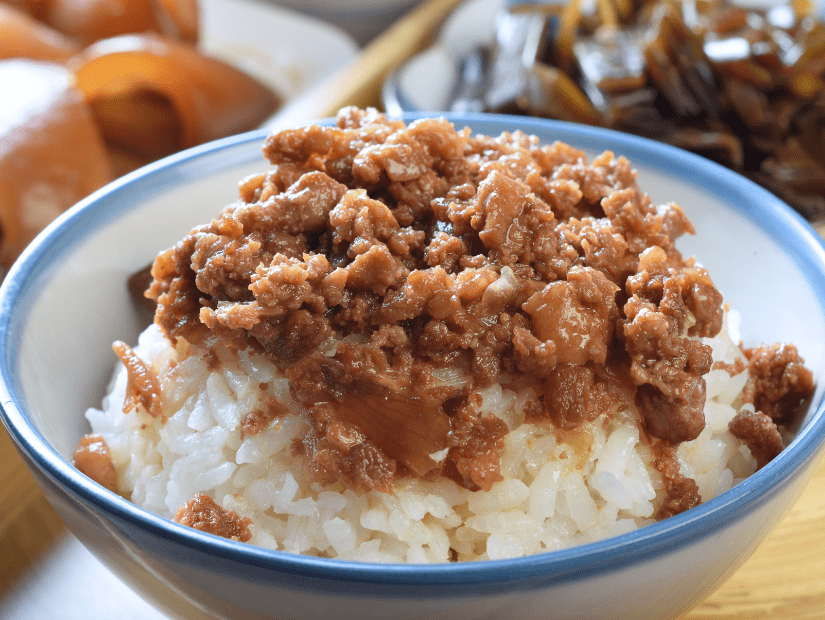
What is it? Bits of pork belly braised in soy sauce and spices and served over a small bowl of rice. Considered the ultimate comfort food by many. (It’s my 6-year-old son’s favorite food in the world!)
Where to find it: Hole-in-the-wall noodles shops.
6. Da Jipai (Fried Chicken Fillet/大雞排)

What is it? Huge chicken fillet hammered flat, seasoned, breaded, and deep fried. Popular night market and late-night snack.
Where to find it: Ximending, night markets, and fried food stalls on street corners across the country.
7. O-A-Mee Sua (Oyster Vermicelli Noodles/蚵仔麵線)

What is it? Wheat vermicelli slow cooked in thick stew and served with oysters and/or pig intestines. Topped with optional cilantro and spicy sauce. Look out for a vegetarian (mushroom based) version; you’ll see 素 (vegetarian)on the sign.
Where to find it: Street carts in the morning (it’s often eaten as breakfast). Ay Chung Rice Noodles (阿宗麵線) in Ximending is very popular among tourists.
You can buy Taiwanese mee sua noodles here to make at home (oysters not included).
8. Tongzai Migao (Sticky Rice Pudding/筒仔米糕)

What is it? Steamed rice with egg yolk, pork and shitake mushroom that is molded in a cup and usually served with sweet red sauce. Also called tube rice pudding (it’s really not at all like pudding, and not to be confused with Whay Guay (#36), which is also sometimes called rice pudding).
Where to find it: Hole in the wall noodle shops. Daqiaotou Rice Cakes (大橋頭老牌筒仔米糕) in Yansan Night Market in Taipei is especially well known for theirs.
9. Green Onion Cakes (Cong Zhua Bing/蔥抓餅)

What is it? Green onion flatbreads pan fried, usually with egg and usually many optional accompaniments, including fresh basil, cheese, spicy sauce, corn, kimchi, and more. Also called scallion pancakes and cong you bing (蔥油餅). I personally recommend getting kim chi AND cheese.
Where to find it: Breakfast shops, Yilan County (especially Sanxing township), night markets, Ximending. Try Michelin-rated Hsiung Chi Scallion Pancakes (雄記蔥抓餅) in Gongguan Night Market, Taipei.
10. Xiaolongbao (Soup Dumplings/小籠包)

What is it? Steamed dumplings containing meat and broth, originating in Shanghai and popularized by Din Tai Fung, Taiwan’s most famous restaurant. Also frequently served on the street as a breakfast food.
Where to find it: Breakfast restaurants (a little rare), breakfast food trucks.
Meaty Delights
Like most Asian countries, Taiwanese cuisine is undeniably meaty. Here are the top meat-focused foods in Taiwan, though meat will make an appearance in other sections too.
11. Ba Wan (Taiwanese Meatballs/肉圓)

What is it? Ball of translucent dough stuffed with pork, bamboo, and shiitake mushrooms, then served in a bowl doused with savory sauce.
Where to find it: Changhua, traditional markets across Taiwan, and Jiufen (one of the most popular day trips from Taipei).
12. Yansu Ji (Salt & Pepper Chicken/鹹酥雞)

What is it? Bite-sized pieces of chicken battered, fried, and seasoned with salt, pepper, garlic, and basil. Also called Taiwanese fried chicken, Taiwanese popcorn chicken, or Taiwanese crispy chicken nuggets.
Where to find it: Street corners and night markets across Taiwan.
13. Pig’s Blood Cake (Zhu Xie Gao/豬血糕)

What is it? Cakes of steamed pig’s blood and sticky rice, often coated in ground peanut powder and served with cilantro and dipping sauce.
Where to find it: Night markets across Taiwan.
14. Flamed Beef Cubes (Huoyan Shaizi Niu/火炎骰子牛)

What is it? A recent trend of barbecuing cubes of beef and further blow torching them to achieve a crispy outside.
Where to find it: Raohe Night Market, Ximending, and more.
15. Grilled Sausages (Xiang Chang/香腸)

What is it? Pork sausages grilled and often served on their own or with raw garlic and green onions. Taiwanese sausages have a hint of sweetness to them.
Where to find it: Night markets, amusement parks, outside nightclubs, and in tourist hotspots across Taiwan.
16. Grilled Mountain Boar (Kao Shanzhu/烤山豬)

What is it? Grilled pieces of Taiwanese mountain pig served with rice or on skewers in aboriginal communities.
Where to find it: Aboriginal areas including Wulai (pictured above) and Ita Thai village at Sun Moon Lake, night markets.
17. Stewed Medicinal Pork Ribs (Yaodun Paigu/藥燉排骨)

What is it? Pork ribs that are stewed in a broth containing a variety of Chinese medicinal herbs.
Where to find it: In night markets across Taiwan. The ones in Raohe Night Market (Chen Dong Medicinal Ribs/陳董藥燉排骨) as well as Yansan Night Market and Shilin Night Market are even recommended in the Taipei Michelin. There’s also one in Keelung Night Market.
18. Black Pepper Buns (Hujiao Bing/胡椒餅)

What is it? Flaky buns stuffed with pork seasoned with black pepper and baked on the inner sides of a round clay oven.
Where to find it: The most famous one is at Raohe Night Market. Other night markets, or watch for the distinctive clay ovens in front of hole-in-the-wall shops the street.
19. Turkey Rice (Huoji Rou Fan/火雞肉飯)

What is it? Strips of turkey meat marinated in a broth with ginger and green onions, then served on a small bowl of rice, and sometimes with a piece of takuan (Japanese pickled daikon). Chicken rice (雞肉飯) is a similar take. Like braised pork rice (lu rou fan), it is simple yet widely loved.
Where to find it: Chiayi, hole-in-the-wall shops across Taiwan.
Rice & Mixed Dishes
Here is an assortment of Taiwanese rice-based dishes and foods that include ingredients from many different categories.
20. Taro Balls with Salted Egg & Pork Floss (Liu Yu Zai Yu Bing/劉芋仔芋餅)

What is it? Balls of taro stuffed with egg yolk and pork floss, and served at one of the country’s most famous night market stalls: Liu Yu Zai (劉芋仔芋餅).
Where to find it: Stall #91, Ningxia Night Market, Taipei.
21. Lu Wei (Braised Foods/滷味)

What is it? A variety of foods that are braised in an aromatic broth with a medley of spices including cinnamon, star anise, ginger, cardamom, clove, Sichuan peppercorn, and fennel. Customers pick and choose with a basket, and it served with more seasonings or in a bowl of the broth. Sometimes there’s a spicy broth option.
Where to find it: Night markets and food stalls everywhere. The lu wei stall called Liangji Lu (梁記滷) in Tonghua Night Market is especially famous.
22. Taiwanese Oden (Guandongzhu/關東煮)

What is it? A variety of fish cakes, meats, vegetables, egg, kelp, and tofu stewed in a fish flake broth. They are ubiquitous in 7-Elevens but also served in some restaurants and night markets. Also called o-lian (黑輪) in Taiwanese. Similar to Tianbula (#41), but with more varied ingredients and without the addition of red sauce.
Where to find it: Watch for the items floating in broth in front of restaurants or in some night markets, such as Nanjichang in Taipei (pictured above).
23. Coffin Bread (Guancai Ban/棺材板)

What is it? A modern innovation consisting of a thick slice of white bread hollowed out and filled with a creamy stew usually containing chicken, seafood, tripe, corn, peas, or mushrooms. Also called coffin lid or coffin board.
Where to find it: Tainan, Shilin Night Market.
24. Bento boxes (Biandang/便當)

What is it? A cardboard lunch box containing pork, braised egg, cabbage, fish, sausage, dougan (firm tofu) and more served on a bed of rice. It originated from Japanese bento boxes served on train platforms, but is now a quick lunch for students and workers across the country every day.
Where to find it: Fulong Train Station (pictured above), which has one of the best beaches in Taiwan, has the country’s most famous bento boxes. Guanshan and Chishang (Taitung) and Fenqihu (Alishan area) are also known for their bento boxes. Many hole-in-the-wall restaurants also prepare them, or you can buy them directly on trains.
25. Zongzi (Sticky Rice Dumplings/粽子)

What is it? Tetrahedral bundles of sticky rice steamed in banana or lotus leaves, and usually containing shiitake mushroom, pork, egg yolk, or other ingredients. Also called rou zong (肉粽) when they contain meat. They are a dish associated with the Dragon Boat Festival, but also served from street stalls year-round.
Where to find it: Watch for them hanging in front of shops, especially around Dragon Boat Festival.
26. Sticky Rice Tubes (Zhutong Fan/竹筒飯)

What is it? A section of bamboo filled with sticky rice, traditionally made by Taiwanese aboriginals for ease of carrying on hunting trips.
Where to find it: Aboriginal communities including Wulai and Ita Thao village at Sun Moon Lake.
27. Taiwanese BBQ (Kao Rou/烤肉)
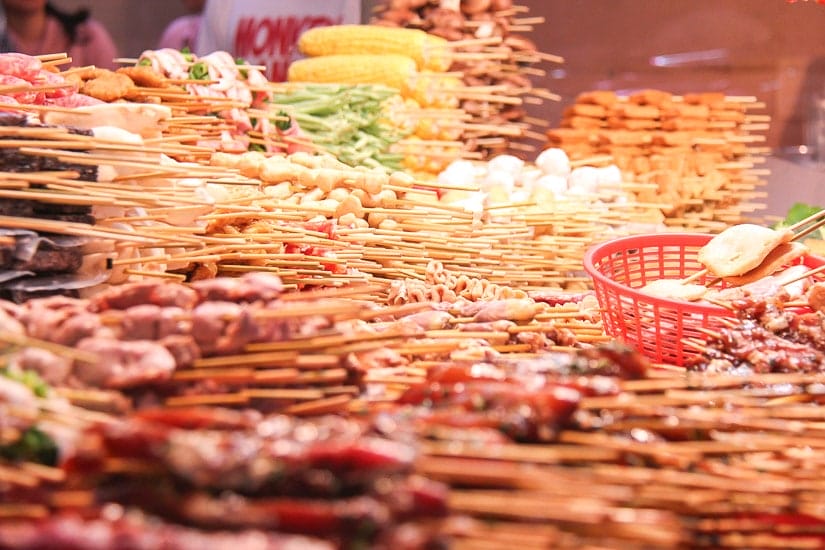
What is it? Skewers of barbecued meats, veggies, seafood, and tofu, seasoned before serving. Customers pick and choose with a basket. Some stalls deep fry the foods before barbecuing them (double yum).
Where to find it: Watch for the piles of skewered items at night markets.
28. Youfan (Oil Rice/油飯)

What is it? Sticky rice slow cooked with pork, soy sauce, ginger, brown sugar, garlic, and shiitake mushrooms. The dish is traditionally gifted by parents to their relatives and friends to celebrate the one month birthday of their baby. Versions sold outside of temples are usually vegetarian.
Where to find it: Outside of temples in Taiwan (try Xingtian Temple in Taipei). The above photos of boxes prepared for one month baby celebrations was shot at the ground floor of Yongle Fabric Market on Dihua Street in Taipei.
29. Small Sausage in Large Sausage (Dachang Bao Xiaochang/大腸包小腸)

What is it? A pork sausage wrapped in a sticky rice sausage and served with sweet soy sauce, garlic clove, pickled veggies, and spicy sauce. You can also order rice sausages (米腸) on their own, but heads up that they may be cooked on the same grill as the meat sausages and may be wrapped in a non-vegetarian skin.
Where to find it: Night markets and tourist hotspots.
30. Herbal Rice Cakes (Tshau-A-Gui/草仔粿)

What is it? Very traditional green colored glutinous rice balls stuffed with crunchy vegetables, and sometimes meat, with strong herbal flavors (it’s an acquired taste). There’s a variation made with taro called O-Gui (芋粿).
Where to find it: Traditional day markets, Ah-Lan (阿蘭草仔粿芋粿) in Jiufen (above photo).
31. Shui Jian Bao (Pan-Fried Buns/水煎包)

What is it? Small buns that are steamed and/or pan fried, and usually filled with either cabbage, leek, or pork; some are vegetarian–just ask You su de ma? (有素的嗎?)
Where to find it: Night markets or stalls on the street.
32. Taiwanese Congee (Zhou/粥)

What is it? A hot porridge made from overcooked rice, with various ingredients added that may include meat, seafood, pork floss, bamboo, pickled vegetables, peanuts, taro, sweet potato, century egg, youtiao (see #79), salted duck egg, and more. It is a standard breakfast in Taiwanese hotels, but also served from street food stalls for breakfast or lunch.
Where to find it: Day markets or hole-in-the-wall noodle shops.
33. Taiwanese Sushi Rolls (Taiwan Shousi/台灣卷壽司)

What is it? While authentic Japanese sushi is common and popular throughout Taiwan, this is a Taiwanese version of maki (sushi rolls), usually containing ingredients such as pork floss, egg, carrot, cucumber, ham, and sweet mayonnaise.
Where to find it: Night markets or Sushi Express (a chain sushi restaurant very popular in Taiwan).
34. Run Bing (Taiwanese Burrito/潤餅)

What is it? A variety of fresh ingredients served like a wrap in a spring roll sheet. May include pork, chicken, carrots, bean sprouts, cabbage, egg, crushed peanuts, and more; you can pick and choose.
Where to find it: Night markets or breakfast food stalls on the street as a pre-made, take-away item.
35. Cheese Stuffed Potato (Qishi Malingshu/起士馬鈴薯)

What is it? A whole baked potato served with cheese sauce and your choice of toppings, including corn, ham, broccoli, and many more.
Where to find it: Try Prince Cheese Potato (王子起士馬鈴薯) in Shilin Night Market, Ximending, and other night markets across Taiwan.
36. Whay Guay (Rice Pudding/碗粿)

What is it: A bowl of rice that has been cooked into a liquid then steamed to form a firm pudding-like texture. It is usually served with ground garlic, wasabi, and sweet soy sauce.
Where to find it: Tainan and hole-in-the-wall eateries across Taiwan. Look for bowls of it waiting to be served in a the same steamer where baozi/mantou (#78) are usually kept.
Taiwanese Seafoods
Being an island nation, it comes as no surprise that seafood is a fundamental part of Taiwanese cuisine. Here are some seafood based treats found at port markets, night markets, and on the streets around the country.
37. Shrimp Rolls (Xia Juan/蝦卷)
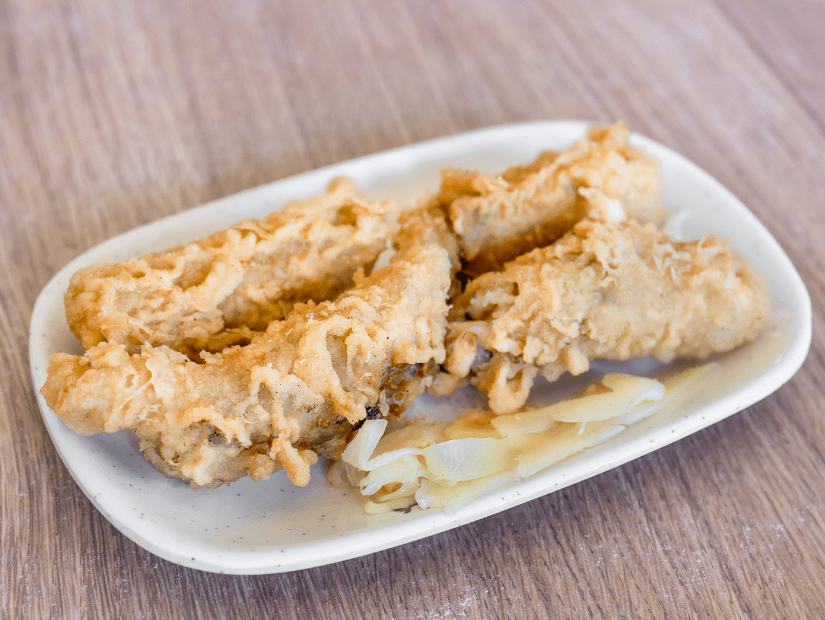
What is it: Rolls of ground shrimp, pork, offal, and shallots wrapped in pig’s diaphragm lining (traditionally) or a thin tofu skin (more common now), then deep fried until crispy and served with a sweet red sauce and green or yellow wasabi sauce.
Where to find it: Hole-in-the-wall shops and street stalls in Tainan. You can also find an oyster version of this in Tainan, especially around Anping Old Street.
38. Grilled Squid (Kao Youyu/烤魷魚)
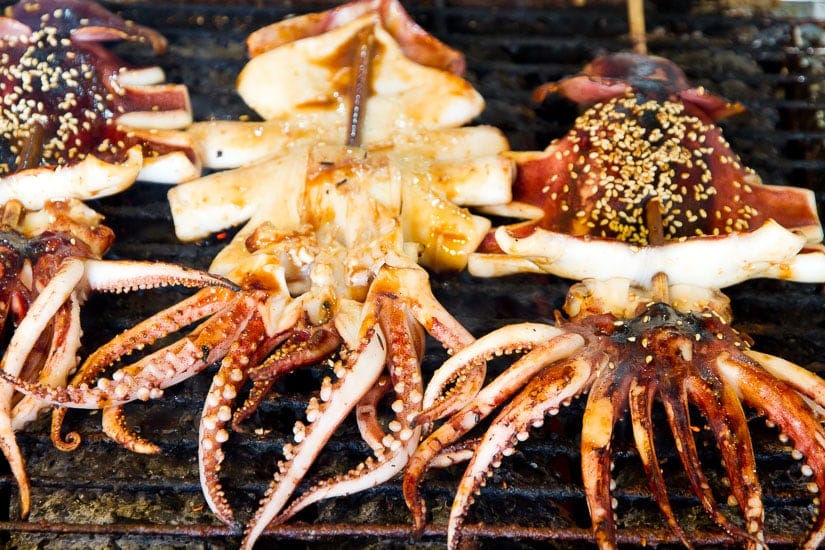
What is it? An entire squid skewered and barbecued with sweet barbecue sauce and usually garnished with sesame seeds.
Where to find it: Tamsui (Danshui), night markets across Taiwan.
39. Deep Fried Cuttlefish (Zha Huazhi/炸花枝)

What is it? Cuttlefish is similar to squid but with a softer texture. It is usually breaded, deep fried, cut into bite-sized pieces, seasoned with white pepper, and served in a paper bowl.
Where to find it: Tamsui (Danshui), night markets across Taiwan.
40. Deep Fried Oyster Balls (O-Te/蚵嗲)
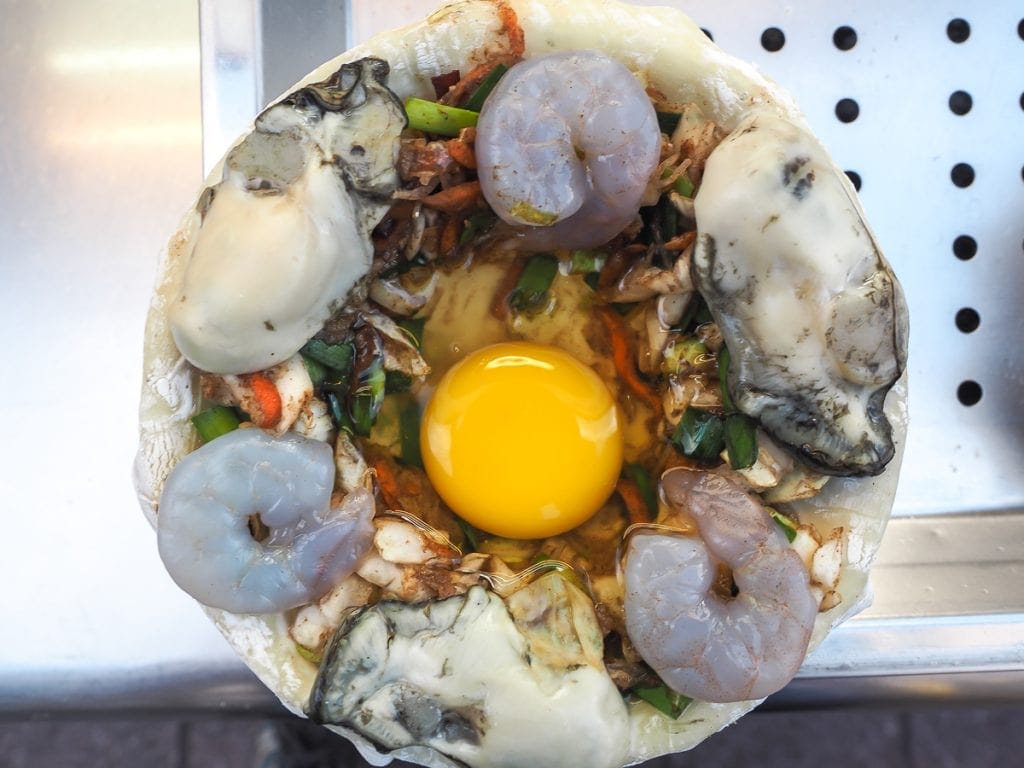
What is it? A deep fried ball of dough filled with fresh oysters, egg, green onions, and sometimes shrimp. Beware of burning hot steam inside, and don’t forget to add soy and/or spicy sauce before you walk away from the stall! The picture above is a model showing what’s inside before being rolled into a ball and cooked.
Where to find it: Chiayi, Nanjichang Night Market, Ningxia Night Maket.
41. Tian Bu La (甜不辣)

What is it? A dish consisting of various fish cakes, tofu, white radish, and pig’s blood cake stewed in a broth then served with sweet red sauce and garnished with cilantro or celery. Similar to Taiwanese oden, but with the addition of the red sauce and more specific ingredients that are always used. The fish cakes themselves are also called tianbula. The dish is sometimes incorrectly referred to as “Taiwanese tempura” because tempura sounds like tianbula.
Where to find it: Night markets and hole-in-the-wall shops. Keelung Night Market is said to have the best tianbula in Taiwan.
42. Flying Fish (Fei Yu/飛魚)

What is it? A unique specialty of Orchid Island and considered sacred by the local Tao (Yami) people. In season (spring), you can find it deep fried, barbecued, or even served in danbing (#72).
Where to find it: Dongqing Night Market on Orchid Island or on the coast of Taitung County.
43. Takoyaki (Zhangyu Xiaowanzi/章魚小丸子)

What is it? A Japanese street snack consisting of fried balls of dough with a chunk of octopus, topped with sweet soy sauce, sweet mayonnaise, fish flakes, and a choice of seasonings.
Where to find it: Night markets across Taiwan.
44. Sio Chiu Le (Shochu Snails/燒酒螺)

What is is: Little sea snails that are marinated in rice liquor, garlic, and other spices. They are sold in a cup, and you need to suck them to get the meat out (or use a toothpick for bigger ones). It’s all about the sauce, though.
Where to find it: Lukang Old Street in Changhua (photo above), port markets, night markets, Tamsui.
45. Grilled Abalone (Kao Bao Yu/烤鮑魚)

What is it? Whole grilled abalones are a common delicacy served in many night markets. They are easy to spot because there is usually a grill totally covered with them.
Where to find it: Fengjia Night Market in Taichung and other night markets across Taiwan.
46. Fried River Fish/Shrimp (Zha Xi Yu/Xia/炸溪魚/蝦)

What is it? Small freshwater shrimps and fish deep fried, seasoned with salt, pepper, and green onions, and eaten whole (including shells/bones). Don’t worry, they are easy to chew!
Where to find it: Wulai Old Street in New Taipei City and Lukang Old Street (where they are called Monkey Shrimps)
47. Sashimi (Sheng Yu Pian/生魚片)
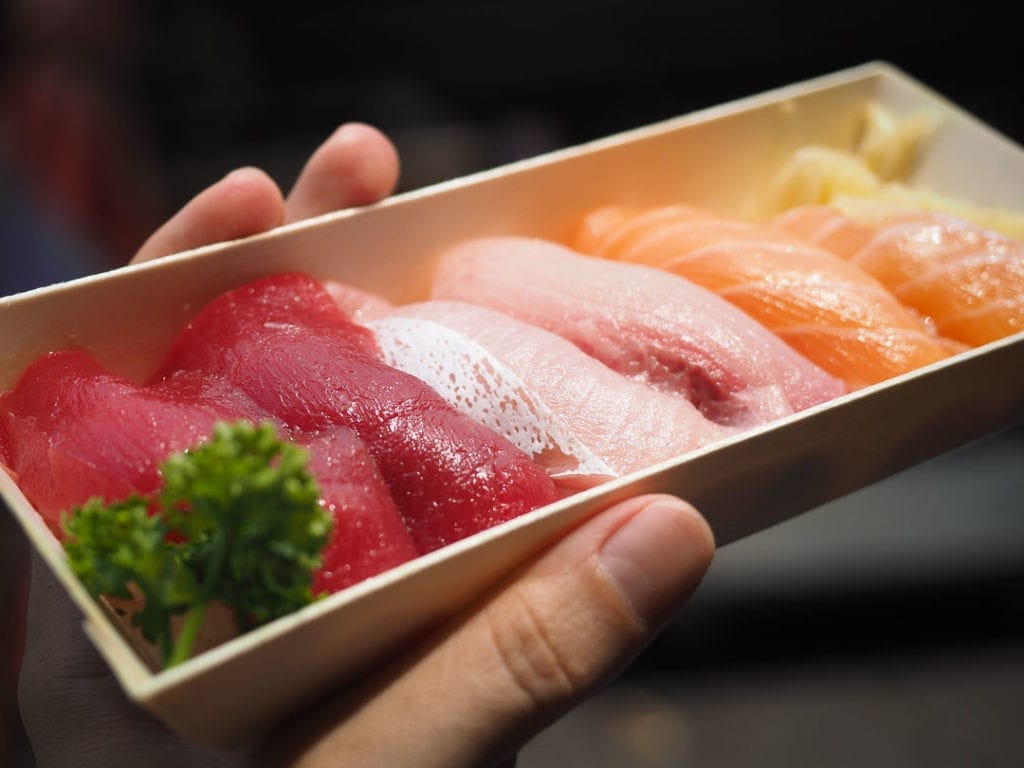
What is it? Sashimi, or raw fish, is extremely popular across Taiwan and quite affordable.
Where to find it: Seafood markets, harbors, sushi stalls in night markets, local quick fry restaurants, Addiction Aquatic Development (a gourmet market with the best seafood in Taipei), Japanese restaurants.
Noodles & Soups
Who doesn’t love a good steaming bowl of noodle soup? Taiwanese sure do! Here are some of the best noodles and soups in Taiwan.
48. Milkfish Stew and Soup (Shimuyu Geng/Tang/虱目魚羹/湯)
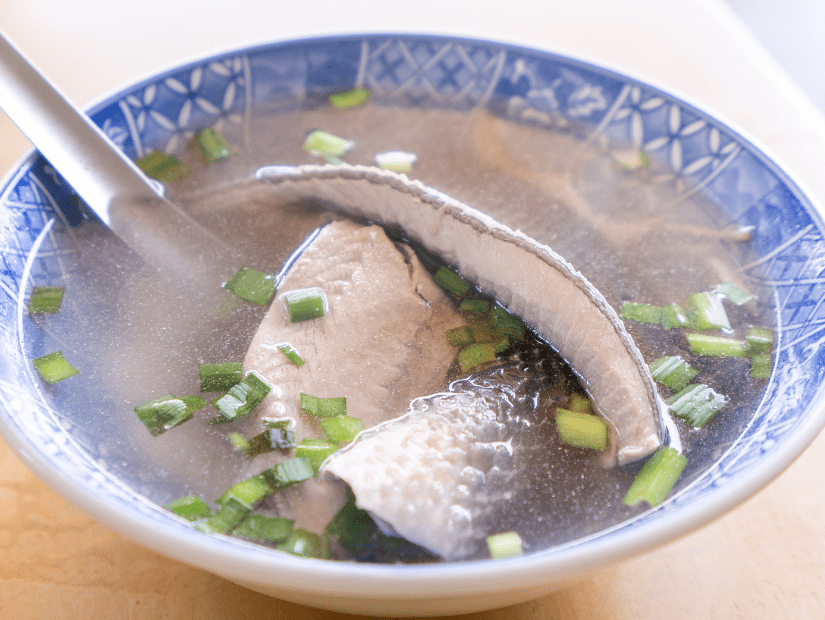
What is it: In stew form, chunks of milkfish paste (similar to fish balls, but not ball shaped) are served in a thick broth. In soup form (pictured above), a whole chunk of milkfish comes in a clear, gingery broth.
Where to find it: Hole-in-the-wall shops in Tainan and Southern Taiwan.
49. Fish Head Soup (Shaoguo Yutou/沙鍋魚頭)

What is it: A highly aromatic and flavorful stew of cabbage, tofu, and (of course) fish heads. Smart Lin’s food stall in Chiayi attained international fame for its fish head soup after being featured on the Netflix docuseries Street Food. My father in law (who comes from Chiayi) makes his own!
Where to find it: Smart Lin Fish Head Soup (林聰明沙鍋魚頭) at #361, Zhongzheng Road, East District, Chiayi City or 科芬園砂鍋魚頭 in Yongle Market in Tainan (see more details in my guide to Tainan).
50. Hot & Sour Soup (Suan La Tang/酸辣湯)

What is it? A thick soup originating in China and containing pork strips, wood ear mushroom, tofu, bamboo, shitake mushroom, soy sauce, and vinegar.
Where to find it: Often served in dumpling shops, but also sometimes in night markets.
51. A-Gei (阿給)

What is it? A fried tofu skin dumpling stuffed with cellophane noodles, sealed with surimi (fish paste), and sometimes pork, and doused in a sweet and savory sauced. Often served alongside fish ball soup or soy milk.
Where to find it: Tamsui district in New Taipei City
52. Danzai Noodles (Ta-A Noodles/擔仔麵)

What is it? A small noodle dish with minced pork, prawn, bean sprouts, black vinegar, garlic, soy sauce, egg, and cilantro. Also sometimes called Danzi Noodles or Slack Season Ta-a Noodles.
Where to find it: Noodle shops and night markets in Tainan.
53. Tu Tuo Yu Geng (Spanish Mackerel Stew/土魠魚羹)

What is it? A thick stew with cabbage, vinegar, green onions, and breaded strips of mackerel. Sometimes served with a choice of noodles, and usually pronounced in the Taiwanese (not Mandarin) way.
Where to find it: Tainan City’s night markets and daytime food stalls, or Yongle Tainan Fried Spanish Mackerel Thick Soup (永樂台南土魠魚羹) on Dihua Street in Taipei.
54. Sian-Hi I-Mi (Eel Noodles/鱔魚意麵)

What is it? Egg noodles in a rich brown sauce or soup and topped with strips of swamp eels stir fried in soy sauce and vinegar. Like the last two entries, it is a Tainan specialty.
Where to find it: Hole-in-the-wall noodle shops and night markets in Tainan city and night markets in Kaohsiung city
55. Squid stew (Youyu Geng/魷魚羹)

What is it? A thick soup with strips of squid, bamboo, carrot, mushroom, and served with fresh basil on its own or with a choice of noodles. Sometimes instead of squid, you can choose cuttlefish or crispy fish (魚酥).
Where to find it: Tonghua (Linjiang) Night Market in Taipei, street vendors around the country (especially at lunchtime), night markets. There is also a crab version sold in Keelung Night Market.
56. Cold Noodles (Liang Mian/涼麵)

What is it? Chilled noodles served with strips of cucumber and carrot, garlic paste, and sesame dressing. Very refreshing in summer! It is sometimes served with a bowl of miso soup. For a unique variation, you can try Burmese cold noodles, which have crispy fried shallots and have a sour taste from the addition of tamarind vinegar.
Where to find it: Night markets and noodle shops across Taiwan. Myanmar Street in New Taipei City for the Burmese version.
57. Hakka Noodles (Kejia Bantiao Mian/客家半條麵)

What is it? Wide rice noodles commonly used in Hakka cuisine. Served in soup or with a rich, meaty sauce and green onions.
Where to find it: Hakka communities in Taoyuan, Hsinchu, Miaoli, and Kaohsiung.
58. Fish ball soup (Yu Wan Tang/魚丸湯)

What is it? Fish balls in a simple meat and/or fish flake broth and garnished with celery or green onions. Sometimes served with noodles, and sometimes the fish balls contain a pork meat center.
Where to find it: Often served as a side dish at noodle shops and hole-in-the-wall restaurants.
59. Mohinga (Burmese Fish Curry Noodles/緬甸魚湯麵)

What is it? A curry noodle dish with banana tree stems and breaded catfish. It is a staple of Myanmar and brought over by Chinese-Burmese refugees who fled to Taiwan.
Where to find it: Myanmar Street in New Taipei City
60. Vietnamese Pho (Yuenan Hefen/越南河粉)

What is it? Vietnamese-style noodles in meat broth and with Taiwanese ingredients, run by (and catering to) Taiwan’s large population of Vietnamese and other Southeast Asian migrant workers.
Where to find it: Small Vietnamese-run noodle shops in the city and small towns all over the country.
Vegetarian, Eggs & Tofu
Taiwan is actually very vegetarian and vegan friendly. Besides the huge number of vegetarian restaurants, you can also find a fair number of vegetarian street foods in Taiwan. Vegetarians, please note that many items in other sections of this article can also be vegetarian, but it’s always best to ask Zhe shi su de ma? (這是素的嗎?)
The Taiwanese also do a lot of interesting things with eggs and tofu.
61. Grilled Mochi (Kao Moji/烤麻糬)

What is it? Cakes of mochi skewered and grilled until crispy on the outside then topped with your choice of sauce of flavorings that can be sweet or savory, including seaweed flakes, teriyaki sauce, ground peanuts, sweetened condensed milk, and more. Some are green (matcha) flavored.
Where to find it: Ximending, night markets across Taiwan.
62. Dou Gan (Dried/Firm Tofu/豆乾)

What is it? A type of firm tofu that is cubed and marinated in soy sauces and spices like star anise and cinnamon, or dried into a kind of tofu jerky that can be sweet, spicy, barbecue flavor, and so on.
Where to find it: Daxi district of Taoyuan City is considered the dougan capital of Taiwan. You can also find it in Hakka communities like Neiwan in Hsinchu or Shengxing and Nanzhuang in Miaoli County.
63. Century Eggs (Pi Dan/皮蛋)

What is it? Eggs that have been preserved in clay, ash, salt, quicklime, and rice hulls until becoming jelly-like, with a translucent black color and creamy green-black yolk. Also called 100-year eggs and 1000-year eggs, their taste and smell is very strong and has even been compared to horse urine. They are often served over a block of cold soft tofu with green onions and sweet soy sauce (皮蛋豆腐, pictured above).
Where to find it: As a side dish in noodle shops or sometimes added to congee or other dishes.
64. Iron Eggs (Tie Dan/鐵蛋)

What is it? Eggs that have been repeated stewed in spices and air dried until they adopt a rubbery texture, and usually sold in packets with different flavors. Compared to century eggs, they are much more palatable to first-timers.
Where to find it: Tamsui and other tourist centers in Taiwan.
65. Tea Eggs (Cha Ye Dan/茶葉蛋)

What is it? Eggs with cracked shells that are hardboiled in a broth of tealeaves and numerous spices. The cracks in the shell produce a marble like pattern on the eggs. Like Taiwanese oden, they are found in every 7-Eleven and can explain that delicious smell when you enter the convenience store. Not the same, but also watch out for hot spring eggs around hot springs in Taiwan!
Where to find it: Convenience stores, Sun Moon Lake (pictured above), and other tourist centers in Taiwan.
66. Fried Quail Eggs (Niao Dan/鳥蛋)

What is it? Small bird’s eggs that are individually fried into balls and then served on a skewer with spices or sauces. A quick, cheap, and tasty snack.
Where to find it: Night markets across Taiwan.
67. Jiucai Hezi (Chive Pockets/韭菜盒子)

What is it? Large, pan fried dumplings filled with chives, egg, and vermicelli. Some breakfast shops with further fry them with an egg if you ask. Don’t forgot to drizzle with soy and/or spicy sauce.
Where to find it: Breakfast shops and street stalls.
68. Deep Fried King Trumpet Mushrooms (Zha Xingbaogu/炸杏鮑菇)
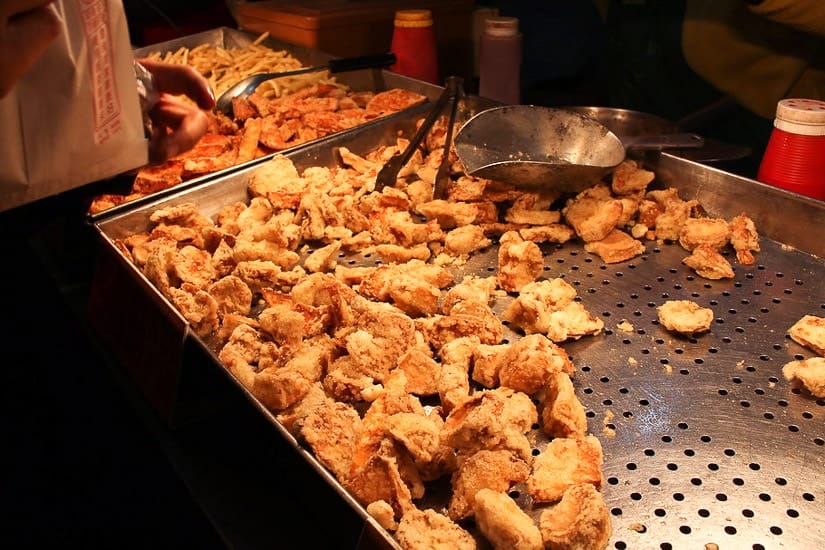
What is it? Huge mushrooms that are common in Taiwan (also called king oyster mushrooms). They are sliced, thickly breaded, deep fried, and served with salt & white pepper.
Where to find it: Night markets and fried food stalls across Taiwan.
69. Taiwanese Grilled Corn (Kao Yumi/烤玉米)

What is it? Whole corn on the cobs bakes and brushed aggressively with a mixture of soy sauce, shacha sauce, sugar, garlic, and sesame oil. They may look blackened and brutalized by the time you eat it, but they are surprisingly tasty.
Where to find it: Dongdamen Night Market in Hualien and other night markets across Taiwan.
70. Tofu Burger (Dougan Bao/豆乾堡)

What is it? A slab of dougan (firm tofu) marinated then sliced open and stuffed with goodies including pickled mustard greens, cilantro, and peanut powder.
Where to find it: Fenqihu Dougan Bao (奮起湖豆乾堡) food stall in Fenqihu, a small village on the Chiayi-to-Alishan small train line.
71. Baked Sweet Potato (Kao Digua/烤地瓜)

What is it? A whole sweet potato or yam baked in a clay oven. Super healthy and filling!
Where to find it: In most convenience stores or from vendors that drive around and prepare them in clay oven on the back of a blue pickup truck.
Taiwanese Breakfast
Taiwanese breakfast is a whole world of its own and one of the great pleasures of living in Taiwan. Since many a breakfast is enjoyed at the streetside in Taiwan (sometimes from 24-hour breakfast shops!), I also include these ubiquitous Taiwanese breakfast foods in my the list.
You can find breakfast shops in almost any neighborhood in Taiwan, while breakfast trucks ply rural and industrial areas. See my favorite traditional breakfast shops in Taipei here, including the city’s most famous breakfast shop, Fu Hang Soy Milk.
72. Dan Bing (Taiwanese Egg Crepe/蛋餅)

What is it? A thin crepe (the item on the left in the above image) that is pan fried with an egg and a choice of toppings that can include cheese, corn, tuna, ham, and more. For a real treat, ask for tuna AND cheese. It’s like a Taiwanese tuna melt!
Where to find it: Virtually all breakfast shops and breakfast trucks have them. Also Feng Chia Night Market in Taichung
73. Shao Bing (Sesame Flatbread/燒餅)

What is it? A flaky pastry that is filled with your choice of egg, cheese, tuna, youtiao (fried dough stick), and more. They are usually freshly baked in the shop and are my personal favorite.
Where to find it: Most traditional breakfast shops, Fu Hang Soy Milk is especially famous for theirs
74. Breakfast Burgers (Mei Er Mei Hanbao/美而美漢堡)

What is it? Burgers for breakfast? Why not!? Choices usually include beef, pork, chicken, bacon, and even seafood burgers like shrimp, fish, and more. Toasted sandwiches are equally common, but they didn’t get their own entry here. According to my wife, the breakfast chain Mei Er Mei was so crucial in popularizing them that Taiwanese call any breakfast hamburgers Mei Er Mei hanbao.
Where to find it: Every breakfast shop has them.
75. Salty Soy Milk (Xian Dou Jiang/鹹豆漿)

What is it? Rather than coffee, most Taiwanese take sweet soy milk or milk tea with the morning meal. But this dish is a thing of its own: a bowl of warm, slightly salted soy milk topped with chunks of youtiao (fried dough stick), green onions, dried shrimp, and crispy browned shallots.
Where to find it: Traditional breakfast shops.
76. Fantuan (Sticky Rice Rolls/飯糰)

What is it? A wad of sticky rice with various ingredients rolled into it, including dried radish, pork floss, egg, pickled mustard greens and/or youtiao. It took me a few years to get into fantuans, but once I did, I never looked back.
Where to find it: Traditional breakfast shops (watch for the large bamboo vat of sticky rice) or inpromptu stalls set up on the street to cater to the morning rush, I recommended a good one near Taipei Main Station here
77. Tie Ban Mian (Iron Plate Noodles/鐵板麵)

What is it? Packs of noodles with a pre-made sauce that are heated up on the flat iron stove (where all the breakfast goodies are cooked), and served with an egg on top. The two standard sauces are black pepper or mushroom (the former is a winner but the latter is a little too reminiscent of spaghetti with tomato sauce for me). A truly filling hangover meal.
Where to find it: Most breakfast shops (but not usually in the more traditional ones).
78. Baozi (Steamed Buns/包子)

What is it? Steamed buns with a variety of fillings. The most basic is mantou (饅頭), a white bun with nothing inside. Common fillings include red bean (dousha bao/豆沙包), taro (yutou bao/芋頭包), pork (zhurou bao/豬肉包), and vegetables (cai bao/菜包). To make a meal of it, ask for a cai bao with a fried egg added to it (cai bao jia dan/菜包加蛋).
Where to find it: Traditional breakfast shops (look for the steamer in the above photo), convenience stores, and dedicated Baozi shops with huge bamboo baskets out front.
79. Youtiao & Soy Milk (Youtiao Doujiang/油條豆漿)
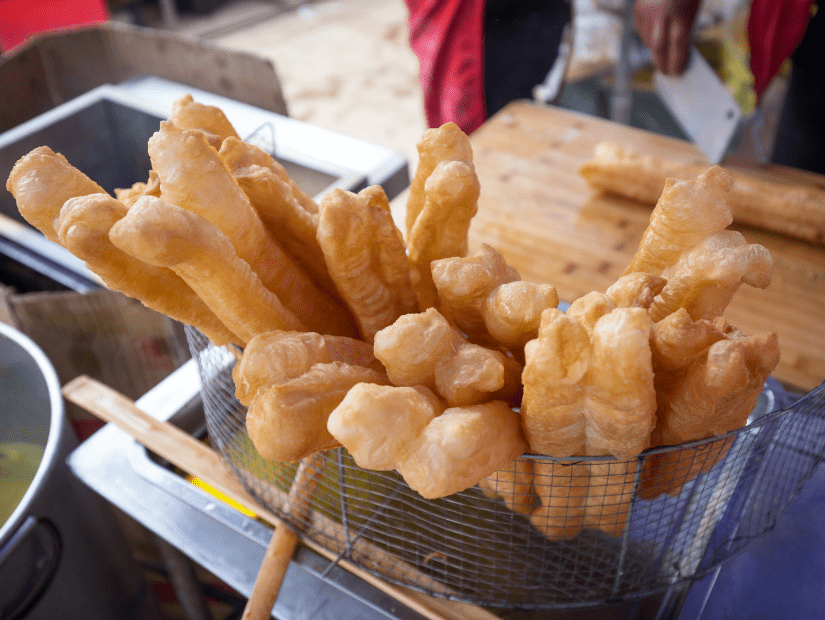
What is it? Youtiao (fried dough sticks) dipped in a cup of (warm or cold, sweet or not sweet) soy milk. A plain but simple breakfast that can still hit the spot.
Where to find it: Traditional breakfast shops; if they have youtiao, you’ll see them.
80. Xiang Su Bing (Sweet Pan Cakes/香酥餅)

What is it? Dry, crispy traditional pastries with sugar, sesame seeds, and other ingredients. For those with a sweet tooth.
Where to find it: They are usually prominently displayed in traditional breakfast shops.
81. Luobo Gao (White Radish Cake/蘿蔔糕)

What is it? A thick cake made from white radish or turnip mixed with flour and served with sweet soy sauce and sometimes crispy browned shallots. Some varieties contain pieces of ham. Also watch for a similar version called you cong guo (油蔥粿).
Where to find it: Almost all breakfast shops have it. For you cong guo, try 郵局前油蔥粿 in Jiufen (pictured above).
Taiwanese Desserts
This section ended up having more entries than any other on the list, and that is telling. Taiwanese definitely have a sweet tooth (some visitors even complain that almost everything in Taiwan seems to be a little sweet).
Here are the best Taiwanese desserts, from traditional to modern, that you are likely to encounter on the streets of Taiwan.
82. Pearl Milk Tea (Zhenzhu Naicha/珍珠奶茶)

What is it? Of global fame, pearl milk tea (also called boba and bubble tea) was invented in Taichung, Taiwan, at least according to the most popular story. The classic version is tapioca balls in sweetened milk tea with ice, but others include passion fruit green tea, taro, and many more. They are seldom slushy drinks like in Western countries.
Where to find it: From tea stands in night markets and on teashops across Taiwan. They are EVERYWHERE.
83. Shaved Ice (Chua Bing/剉冰)

What is it? Traditionally, a mound of shaved ice with a variety of QQ (chewy) toppings beans (you can usually choose 3-5), and doused in black sugar syrup. Modern varieties come with various fruits, ice cream, sweetened condensed milk, matcha, chocolate, and more. Also watch for a xuehuabing (雪花冰), a sort of cross between shaved ice and traditional Taiwanese ice cream consisting of thin layers or ice cream.
Where to find it: Night markets, Ximending, and dessert shops. Just watch for people enjoying mounds of it. Yongkang Street in Taipei is known for its mango shaved ice (pictured above).
84. Taiwanese Ice Cream (O Bing/芋冰)
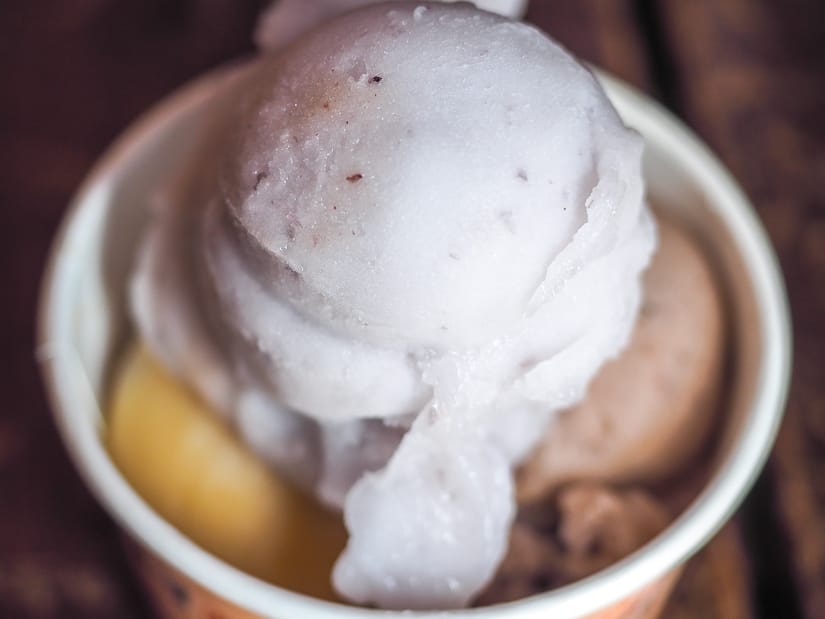
What is it? Traditional ice cream that is usually dairy free and more like sorbet than creamy. Typical flavors include pineapple, lychee, longan, peanut, and taro (the classic flavor that lends its name to all traditional Taiwanese ice creams).
Where to find it: From pushcarts and bicycle peddlers or local ice cream shops like Yongfu Ice Cream (永富冰淇淋) in Taipei or Qilin Ice Cream (奇淋冰品) in Yilan.
85. Peanut Ice Cream Wraps (Huasheng Bingqilin Juan/花生冰淇淋卷)

What is it? Also called ice cream burritos, these are wraps with Taiwanese ice cream, shavings from a huge block of peanut brittle, and cilantro. While that may sound like an odd combination, they are sweet, refreshing and really delicious.
Where to find it: Yilan (especially Luodong Night Market), Jiufen Old Street, Shifen Old Street, and other tourist hotspots around Taiwan.
86. Jiufen Sweet Potato & Taro Balls (Jiufen Digua & Yutou Yuan/九份地瓜&芋頭圓)
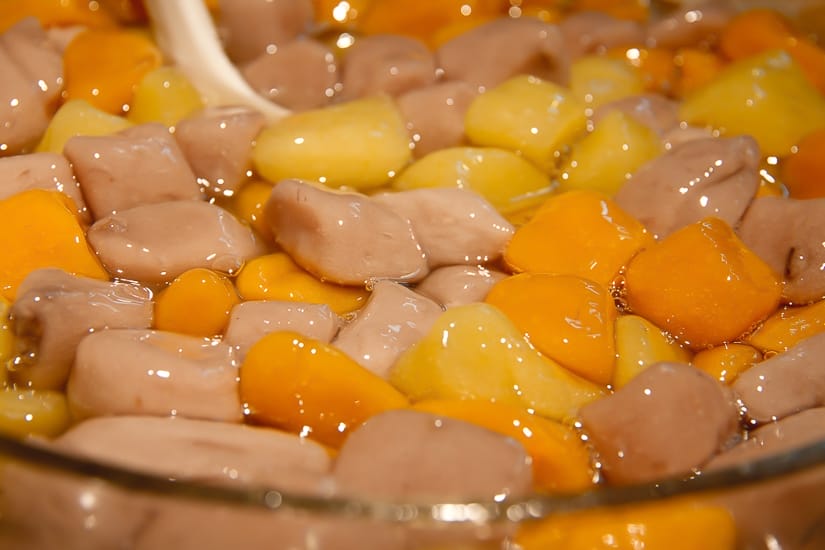
What is it? Doughy balls of sweet potato and taro that are served with sweet syrup either warm or over ice.
Where to find it: At numerous shops in Jiufen. The balls are also sometimes also a topping option for traditional shaved ice. (Personal note: my wife’s family owns a shop in New Taipei City that makes these!)
87. Fried Sweet Potato Balls (Digua Qiu/地瓜球)

What is it? Balls of sweet potato (and sometimes taro: 芋頭球) that are deep fried. Think of them as the Taiwanese answer to donut holes–crispy on the outside, gooey on the inside.
Where to find it: Night markets across Taiwan; Gongguan Night Market in Taipei has an especially popular stall.
88. Aiyu Jelly (愛玉) and Frog’s Egg Drink (Qingwa Xiadan/青蛙下蛋)

What is it? Aiyu is a jelly made from the seeds of a fig tree and is served with lime juice and honey. It is especially refreshing in summer. Frog’s egg drink contains small tapioca pearls with hard white centers, resembling frog’s eggs. The two are often sold from the same stall.
Where to find it: Night markets and street corners across Taiwan; watch for the big frog on the sign or the huge bowl of aiyu (photo above) on display.
89. Candied Fruit (Tanghulu/糖葫蘆)

What is it? Skewers of candied cherry tomatoes or strawberries, often with sour plum. Local kids love them!
Where to find it: You can’t miss the rows of skewers when you spot them; try Ningxia Night Market in Taipei or Fengjia Night Market in Taichung.
90. Wheel Cakes (Che Lun Bing/車輪餅)

What is it? Japanese style round cakes filled with red bean (紅豆餅), custard (奶油餅), or sometimes matcha (抹茶餅). Best when you can get them freshly made and still warm!
Where to find it: Night markets and pushcarts across Taiwan.
91. Taiwanese Waffles (Song Bing/鬆餅)

What is it? In Taiwan, waffles are more than just a dish to order in fancy brunch restaurants. They are also sold on the street as snacks, coming in various sizes and flavors, often eaten as is, or with whipped cream, fruit, and other toppings.
Where to find it: Night markets across Taiwan.
92. Deep fried milk (Zha Xiannai/炸鮮奶)

What is it? Chunks of thick, sweet milk that are frozen, battered, and deep fried to achieve melty goodness inside. Who would have thought?
Where to find it: Shilin Night Market, Tamsui, and other night markets.
93. Red Turtle Cakes (Ang-ku-koe/紅龜粿)

What is it? A very traditional glutinous rice cake dyed red and stuffed with red bean. You may also find the peanut-flavored version pictured above (my personal fave).
Where to find it: 老順香糕餅店 on Temple Street in Xinzhuang district of New Taipei City (my neighborhood!) and other traditional bakeries or day markets around Taiwan.
94. Douhua (Tofu Pudding/豆花)

What is it? A warm or chilled dessert made from soft tofu, boiled peanuts, red beans, and sweet syrup.
Where to find it: In night markets or from douhua trucks that drive around neighborhoods in the evening and call out “daohui!” (“douhua” in Taiwanese) through loudspeakers. You can find a salty sweet version at Cigu Salt Mountain in Tainan.
95. Brown Sugar Cake (Hei Tang Gao/黑糖糕)

What is it? A steamed (not baked) rice flower cake sweetened with brown sugar, sometimes with toppings like dried fruits or sesame seeds.
Where to find it: Hakka communities like Neiwan and Nanzhuang, Magong in the Penghu Islands.
96. Lei Cha (Hakka Pounded Tea/擂茶)

What is it? A warm (or sometimes iced) drink made by pounding tealeaves and a variety of roasted nuts, grains, seeds, herbs, and seasonings, adding hot water, and topping with popped rice. It is often served with mochi.
Where to find it: Hakka communities such as Neiwan (we loved 阿珠客家擂茶, pictured above, where you can pound your own tea for a small fee) and Beipu in Hsinchu County (just type “擂茶” into GoogleMaps to find them).
97. Mochi (Rice Cakes/麻糬)

What is it? Glutinous rice that has been pounded into super QQ (gooey/chewy) balls and eaten as a sweet dessert. There are different Taiwanese varieties as well as Japanese style mochi introduced during the Japanese colonial period. Hakka versions are usually coated with peanut or sesame powder, while Taiwanese ones sometimes contain red bean paste. It can also be grilled (#61) or served on shaved ice (image above).
Where to find it: Night markets, pushcarts on regular streets (Bulao Hakka Traditional Mochi/不老客家傳統麻糬 in Taipei is an extremely popular one), Hakka communities in Taoyuan, Hsinchu, and Miaoli.
98. Nougat (Niugatang/牛軋糖)

What is it? A softer and chewier version of European nougat, coming in a wide variety of flavors and often containing nuts, dried fruits, or other ingredients. Taiwanese often buy it as gift for family members when coming home from a trip somewhere in Taiwan.
Where to find it: Tourist hotspots, especially ones frequented by domestic tourists.
99. Papaya Milk (Mugua Niunai/木瓜牛奶)

What is it? Many fresh fruits and blended fruit drinks are available in night markets, but fresh papaya blended with milk is one of the most popular. Some Taiwanese jokingly say that drinking a lot of it will make women’s breasts larger!
Where to find it: Night markets across Taiwan. There is an especially famous papaya milk stall at Liuhe Night Market in Kaohsiung.
100. Candied Sweet Potato (Mi Digua/蜜地瓜)

What is it? Big chunks of sweet potato candied in maltose sugar. Sweetness overload!
Where to find it: Wulai, night markets across Taiwan.
101. Portuguese Egg Tarts (Pu Shi Dan Ta/普式蛋撻)

What is it? Portuguese and English-style flaky tarts with creamy custard that made their way to Taiwan via Macau and Guangdong. Best when served warm!
Where to find it: Night markets and bakeries across Taiwan.
Thank you for making it to the end of the ultimate bucket list of Taiwanese foods. What did I miss? I know there are more many more, but I had to stop somewhere. Please mention your favorites in the comments below!



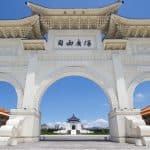
What a great article. I consider myself to be a massive Taiwanese food enthusiast, and I will eat everything, but there are items here that even I have never tried. Taiwanese food is the best cuisine in the world. Thank you for the invaluable information here that displays how truly amazing, delicious and varied the food is on this beautiful little island.
Thanks, Amy, I really appreciate that! And it’s definitely a cuisine that deserves more attention internationally, but that is slowly changing!
Thank you for posting this article. Brings back wonderful memories of all the foodie delights in Taiwan.
That’s a great list, and includes most of the things I thought of. I’ve tried most of those (I’m not into shellfish) and the wife makes several of them herself.
The only one I really want to try that I haven’t is the deep-fried milk.
I could suggest also adding to the list the Pineapple Cakes; Brown Sugar puffs; and the dried fish strip snacks.
Thanks for the tips! I guess I didn’t include the famous pineapple cakes, because they are more of a bakery or souvenir item than a street food. And adding more would mess up my 101 number LOL. It would probably be possible to expand the list to 201 items even, there are just so many cool street foods in Taiwan! Thanks for the input though – I’ll see if I can sneak those in, and nobody will count 🙂
Thankyou so much for your posts,I am finding it so useful to read while in Taiwan.So helpful and well written.
I travelled many countries but never been in Taiwan. Planning to go this year 2024. Thank you so much for this information. I love to eat. I love street food. Thanks, Nick